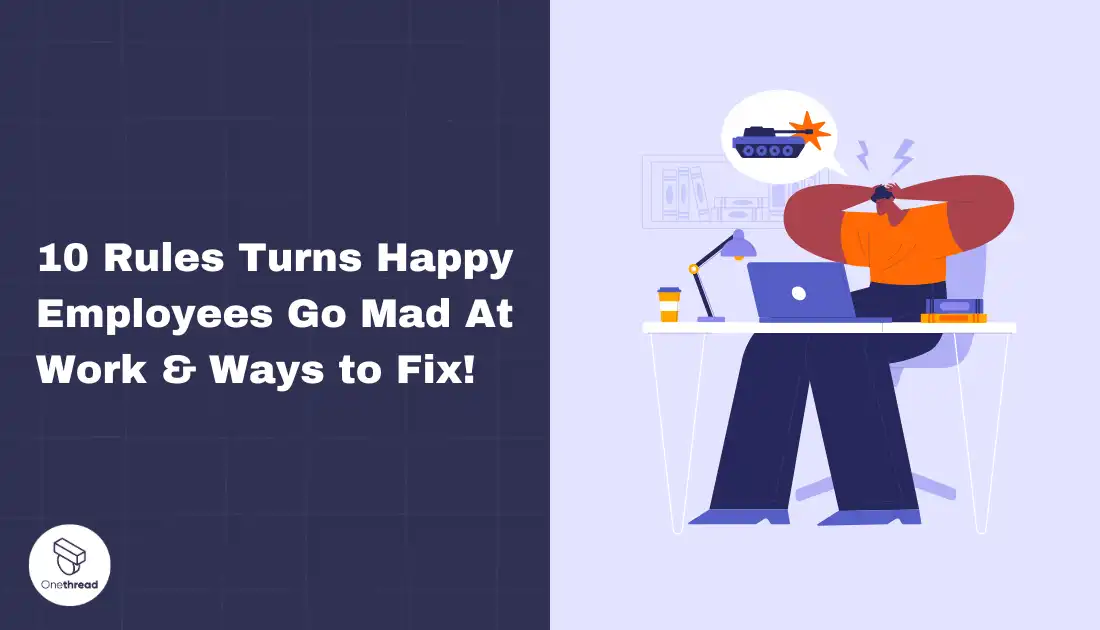Are you frustrated with declining employee morale and engagement at your company? Many well-intentioned management practices can actually have the opposite effect, causing previously happy workers to dread coming into the office.
Policies intended to increase oversight and accountability often backfire, breeding resentment and mistrust. Even perks like free snacks can lose their appeal over time.
The good news is that with some simple adjustments, you can turn this trend around. Read on to learn 10 common rules to rethink that will reignite passion and purpose for your team and proven methods to fix this!
Key Takeaways
- Rethink Rigidity: Excessively strict rules can suffocate creativity and morale. Trusting employees with autonomy enhances productivity and job satisfaction.
- Value Well-being: Ignoring the personal growth and well-being of employees can diminish morale. Support and flexibility lead to a more engaged and content workforce.
- Fairness is Fundamental: Inequitable pay and lack of recognition can erode trust and loyalty. Transparent and fair treatment is key to maintaining a motivated team.
- Cultivate Culture: A positive workplace culture, underpinned by respect, safety, and open communication, is crucial for fostering employee happiness and productivity.
- Leverage Modern Tools: Leverage modern tools like Onethread to increase employee happiness and productivity more efficiently.
Try Onethread
Experience Onethread full potential, with all its features unlocked. Sign up now to start your 14-day free trial!
The Counterproductive Nature of Strict Workplace Rules
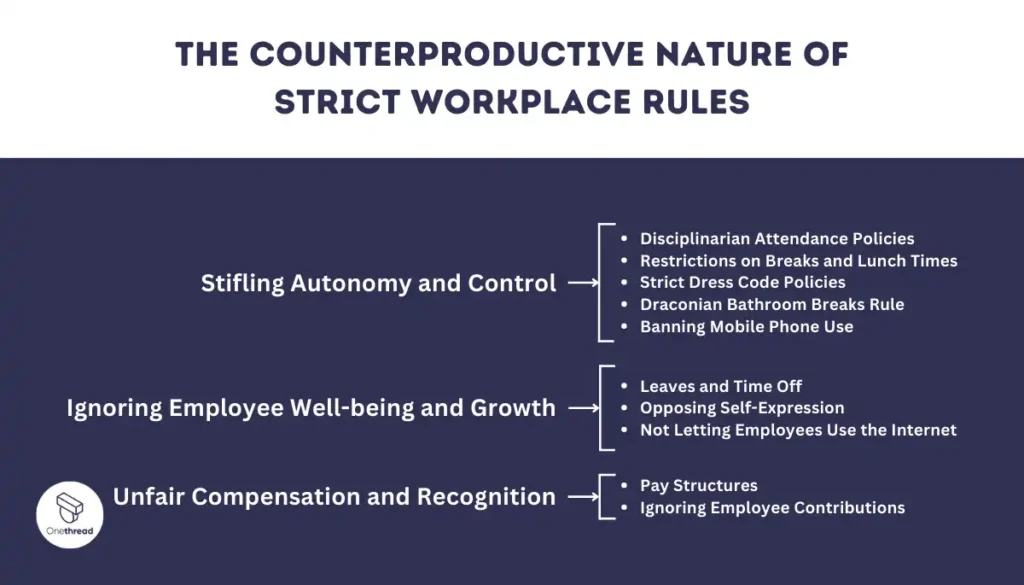
Strict workplace rules often backfire, stifling creativity and morale. They create a rigid environment that can frustrate employees. Let’s discuss 10 rules that turn happy employees mad at work.
Stifling Autonomy and Control
Strict rules at work can make employees feel like they’re under a microscope, taking away their sense of control and freedom. Let’s explore how these rules impact the workplace.
1. Disciplinarian Attendance Policies:
These rules are all about when you come in and leave work. If you’re late or want to leave early, there could be big penalties. This feels unfair because it doesn’t trust workers to manage their own time.
It’s like saying, “We don’t think you know how to do your job unless we’re watching every second.” But really, people work better when they’re trusted to make their own schedules, as long as the work gets done.
2. Restrictions on Breaks and Lunch Times:
Imagine being told exactly when you can have a break or lunch, with no wiggle room for when you’re actually hungry or need a rest. It’s like being back in school, where everything is scheduled.
But we’re not kids; we’re adults who can decide when we need to take five. This rule doesn’t help because everyone needs a break at different times to stay fresh and do their best work.
3. Strict Dress Code Policies:
Dress codes can be super strict, telling you exactly what to wear, even if it doesn’t fit the job or what you like. It’s like wearing a uniform even though we’re not in a team sport.
This rule misses the point that when people feel good about what they wear, they work better. It’s about finding a balance between looking professional and feeling like yourself.
4. Draconian Bathroom Breaks Rule:
This one’s tough. Some places limit how often you can go to the bathroom, which feels really invasive. It’s like being watched all the time and not being trusted to decide when you need a break.
Everyone needs to go to the bathroom, and making this a rule doesn’t make sense. It’s important to treat people with respect and trust that they know their own needs.
5. Banning Mobile Phone Use:
Some workplaces say no to phones completely, even for important personal stuff. This is tricky because phones are a big part of our lives, for emergencies or quick breaks.
This rule seems like it’s saying, “We don’t trust you to not get distracted.” But really, most people can balance a little phone time without messing up their work. Plus, phones can be helpful for the job, too.
Ignoring Employee Well-being and Growth
When companies don’t pay attention to their employees’ happiness and growth, it’s like forgetting to water a plant. Let’s dive into how ignoring these important parts can make the workplace a tough spot.
6. Leaves and Time Off:
It’s really hard for some people to get a break. Whether it’s a vacation or a sick day, it seems like a big ask. Imagine feeling like you can’t even take a day off when you’re not feeling well or needing some time to relax.
This is like saying, “We only care about the work you do, not how you’re feeling.” But here’s the thing: when people get the time off they need, they come back stronger and ready to do great work. Supporting work-life balance isn’t just nice; it’s necessary for a team to do their best.
7. Opposing Self-Expression:
Imagine going to a place every day where you can’t be yourself. You have to dress a certain way and act a certain way, and you’re not allowed to share your ideas or be creative. It’s like being in a play where everyone has to wear the same costume and say the same lines.
But when people can show who they are, they’re happier and more productive. Creativity and individuality aren’t just good for the employees; they bring new ideas and energy to the workplace.
8. Not Letting Employees Use the Internet:
Nowadays, the internet is like a huge library and a meeting place all in one. But some places put a big lock on it, saying it’s too distracting. This is like telling a chef they can’t use a knife because they might cut themselves.
Sure, it’s important to stay focused, but employees often need the internet to find information, solve problems, and talk to each other. Trusting employees to use the internet wisely can lead to better work and more innovation.
When workplaces ignore what employees need to be happy and grow, they’re missing out on a lot of good stuff. It’s like having a garden and not taking care of it.
You won’t get any flowers, and nobody wins. But when companies listen, trust, and support their teams, amazing things can happen. Everyone feels better, does better work, and can reach higher than they thought possible.
Unfair Compensation and Recognition
When people work hard, they expect to be paid and recognized fairly. But sometimes, that doesn’t happen. Let’s look at why fair pay and saying “thank you” for a job well done is super important.
9. Pay Structures:
Think of a time when you did the same chores as a sibling, but they got more allowance. That felt unfair, right? In many places, people feel the same about their pay. They work just as hard (or harder) and have the same experience (or more) as others, but they don’t get paid the same.
This is like saying, “Your work doesn’t matter as much,” which isn’t fair at all. Also, when bosses don’t tell you how they decide who gets paid what, it’s like trying to play a game without knowing the rules. Plus, trying to get a raise or a better job title can be really hard, like climbing a mountain without a map.
10. Ignoring Employee Contributions:
Now, imagine working on a big project, like a science fair project, and nobody says “good job” when you’re done. That’s how it feels when companies don’t notice how hard their employees work. Not being thanked or recognized is like being a ghost at your own party.
And when there’s no chance to learn new things or get better at your job, it’s like being stuck in the same grade forever. Everyone wants to grow and feel like their work is making a difference. When that doesn’t happen, it’s not just sad; it’s a missed opportunity for everyone.
In a nutshell, when companies don’t pay people fairly or recognize their hard work, they’re not just hurting feelings; they’re hurting their own success.
Fair pay and saying “thanks” aren’t just nice things to do; they’re must-haves for a happy, thriving place to work. Everyone deserves to feel valued and to know that their work matters.
When companies get this right, everyone does better, and the workplace becomes a place where people don’t just show up; they shine.
Signs of Unhappy Employees
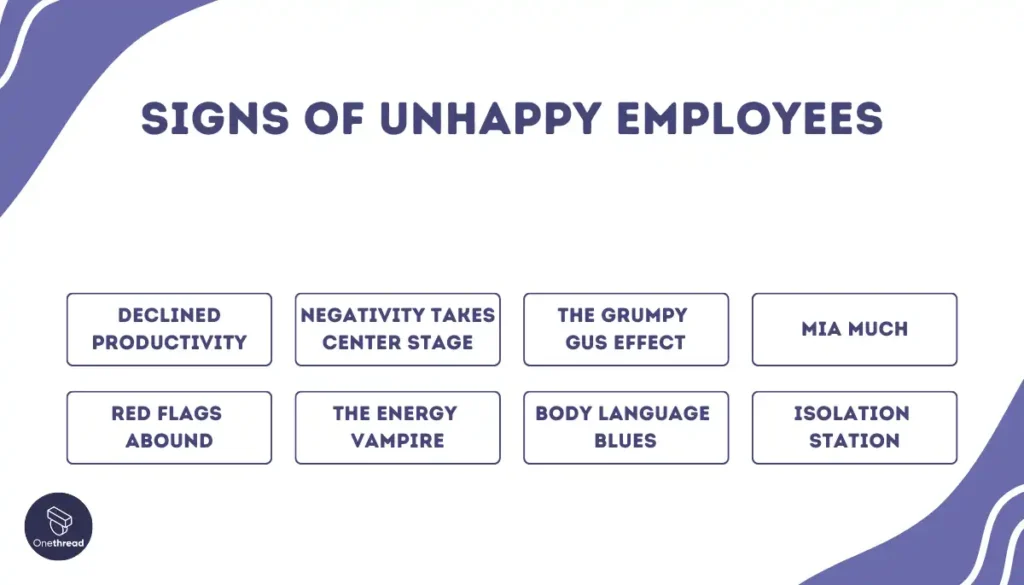
Recognizing unhappy employees early can prevent a ripple effect of negativity and disengagement in the workplace. Here’s how to spot the signs and what employers can do to create a more positive environment.
1. Declined Productivity:
- Colleagues complain: Concerns about someone’s performance or work ethic are surfacing.
- Absenteeism on the rise: Frequent absences might be signaling distress.
- No motivation in sight: Tasks and deadlines are approached with indifference.
What employers can do: Foster open communication, set clear expectations, and explore the reasons behind these behaviors to find solutions.
2. Negativity Takes Center Stage:
- Dip in productivity: Output and enthusiasm are waning, and deadlines are missed.
- Increased tardiness: Consistent lateness might mean a lack of engagement.
- Needing more feedback: Repeated requests for feedback could indicate insecurity.
What employers can do: Offer regular feedback, define achievable goals, and provide growth opportunities to uplift spirits.
3. The Grumpy Gus Effect:
- Negative attitude: A prevailing sense of discontent and dissatisfaction.
- Attitude change: A noticeable shift from a positive to a negative demeanor.
- Decreased professionalism: Ignoring dress codes and showing disrespect.
What employers can do: Directly address issues, cultivate a supportive atmosphere, and encourage positive interactions.
4. MIA Much:
- Missed deadlines: Increasingly missing the mark on assignments.
- More time off: High usage of personal leave and vacation time.
- Doing the bare minimum: Lack of effort and enthusiasm in tasks.
What employers can do: Understand the root causes of absenteeism, set clear job expectations, and inspire engagement through meaningful work.
5. Red Flags Abound:
- Frequently calling in sick: Regular absences, especially at convenient times.
- Irritability: Low tolerance and frequent conflicts with colleagues.
- Missing in Action: Often unaccounted for during work hours.
What employers can do: Implement fair attendance policies, address stress factors, and maintain open lines of communication.
6. The Energy Vampire:
- Negative energy: Spreading gloom and impacting team morale.
- No care about others: Showing indifference to team dynamics and support.
- Refusal to collaborate: Avoiding teamwork and contributing to stagnation.
What employers can do: Tackle disruptive behavior, promote collaboration, and provide training in conflict resolution.
7. Body Language Blues:
- Tired and fatigued: Constant signs of exhaustion and lack of focus.
- Body language changes: Non-verbal cues of disengagement and discomfort.
- Easily distracted: Difficulty maintaining concentration on work tasks.
What employers can do: Look into potential health or stress-related causes, offer flexible scheduling, and minimize workplace distractions.
8. Isolation Station:
- Isolation: Preferring solitude over team interaction and collaboration.
- Loss of interest in company events: Avoiding participation in team or company activities.
- Changes in personal habits: Noticeable shifts in appearance or behavior.
What employers can do: Reach out to offer support, encourage participation in team activities, and ensure an inclusive culture where everyone feels valued.
Addressing these signs with empathy, support, and proactive measures can help transform an unhappy workforce into a thriving one.
Proven Methods to Increase Employee Happiness and Productivity
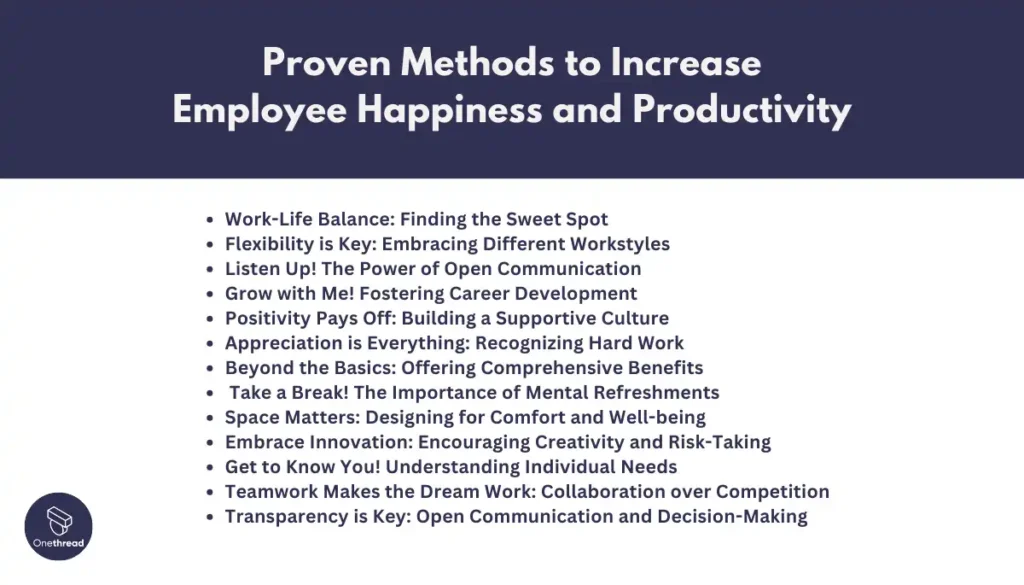
a workplace where everyone feels valued, supported, and excited to come to work each day. Sounds pretty great, right? Well, the good news is that creating such a happy and productive environment isn’t just a dream – it’s achievable! By implementing some key strategies, you can help your team thrive and watch your business flourish.
Here are 13 proven methods to increase employee happiness and productivity:
1. Work-Life Balance: Finding the Sweet Spot
Just like a plant needs both sunshine and water, employees need a healthy balance between work and personal life.
Encourage flexible schedules, offer remote work options when possible, and be supportive of family needs.
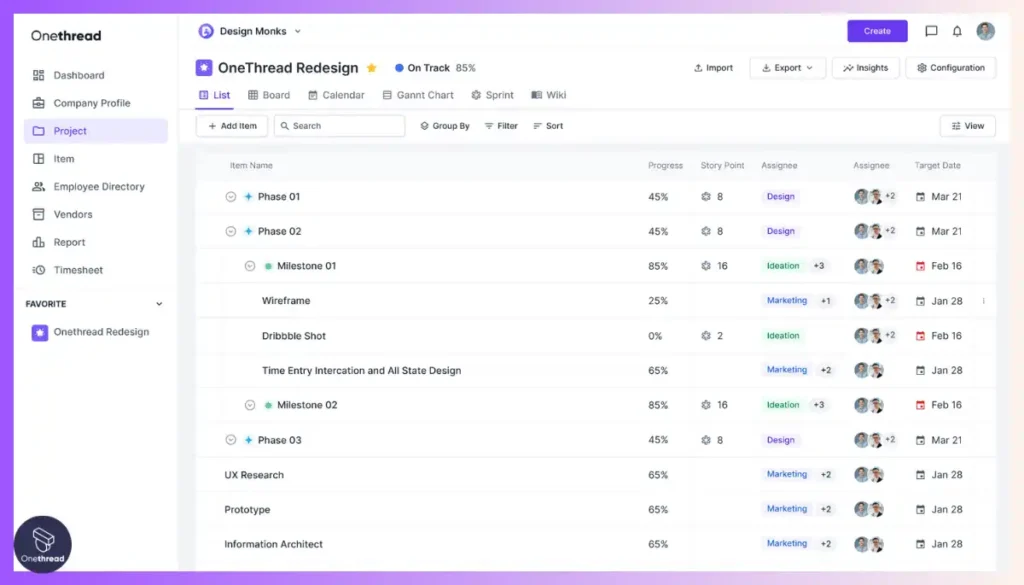
Onethread’s project planning and task management features enable employees to work flexibly, aligning with their personal schedules and enhancing productivity.
For example, employees can easily see their workload for the week, prioritize tasks, and collaborate with colleagues in real time, regardless of their location. This flexibility empowers employees to manage their time effectively and achieve a healthy work-life balance.
Try Onethread
Experience Onethread full potential, with all its features unlocked. Sign up now to start your 14-day free trial!
2. Flexibility is Key: Embracing Different Workstyles
Not everyone thrives in a traditional office setting. Offering remote and hybrid work options allows employees to choose where they work best, fostering a sense of trust and autonomy.
Imagine the boost in productivity when someone can work from home without distractions, or collaborate with colleagues from across the globe!
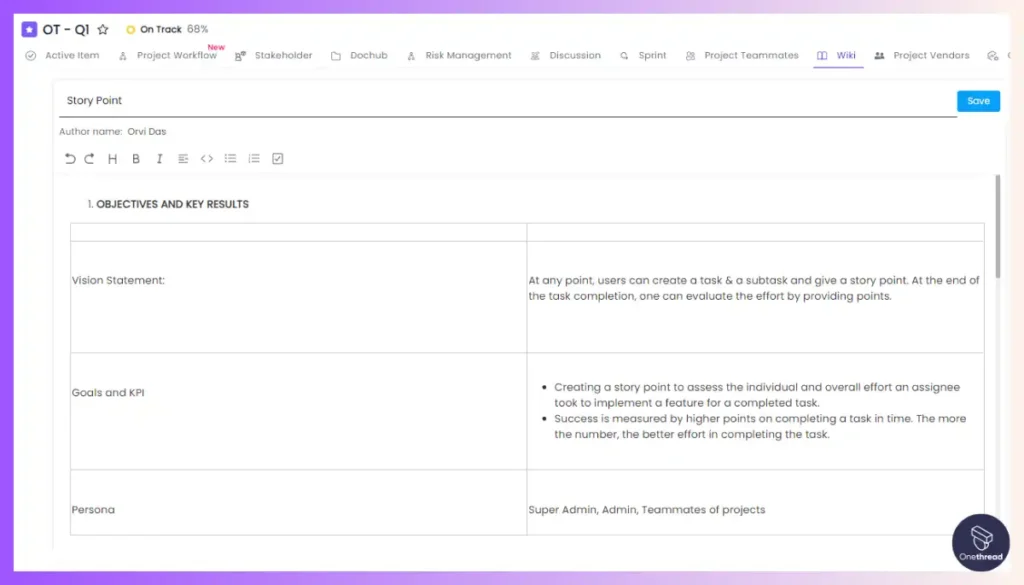
Onethread also facilitates flexible work arrangements by providing secure online collaboration tools and centralized project information. Team members can access project details, share updates, and communicate seamlessly, regardless of their physical location.
This fosters a sense of inclusion and empowers employees to contribute their best work, even when working remotely.
3. Listen Up! The Power of Open Communication
Employees want to feel heard and valued. Create an environment where they feel comfortable sharing their ideas, concerns, and suggestions. Hold regular meetings, implement open-door policies, and actively listen to their feedback.
Remember, happy employees are more engaged and invested in their work when they feel like their voices matter.
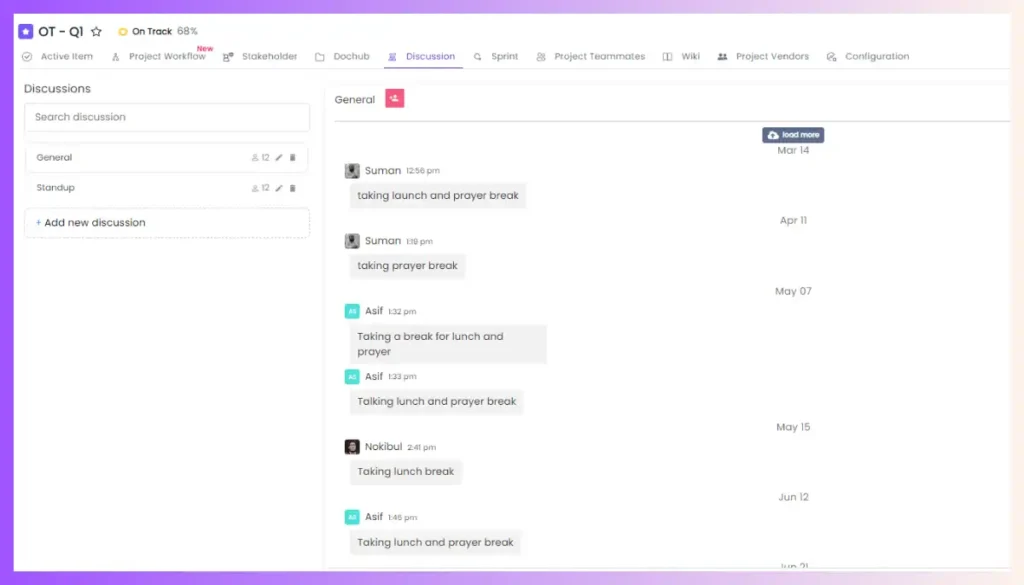
Onethread’s built-in discussion feature enables open communication and real-time collaboration within projects. Team members can easily share ideas, ask questions, and provide feedback directly within the context of their work.
This promotes transparency, fosters a culture of open communication, and empowers employees to actively participate in decision-making processes.
4. Grow with Me! Fostering Career Development
Nobody wants to feel stuck in a dead-end job. Offer opportunities for career development, mentorship programs, and clear pathways for advancement.
By helping employees grow professionally, you show them you’re invested in their future and keep them motivated and engaged.
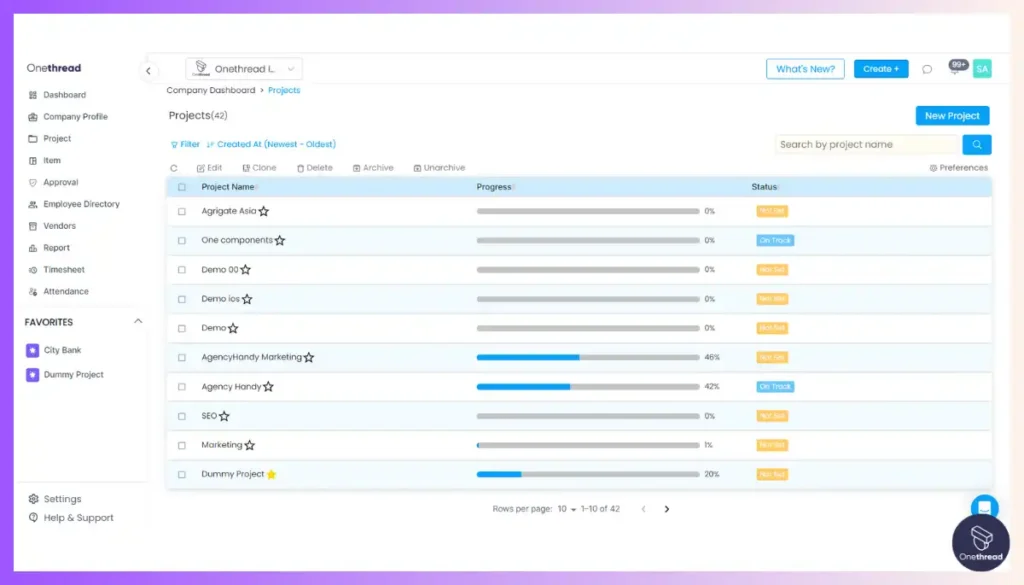
With Onethread, you can track progress and set goals, supporting professional growth and development, and keeping employees motivated.
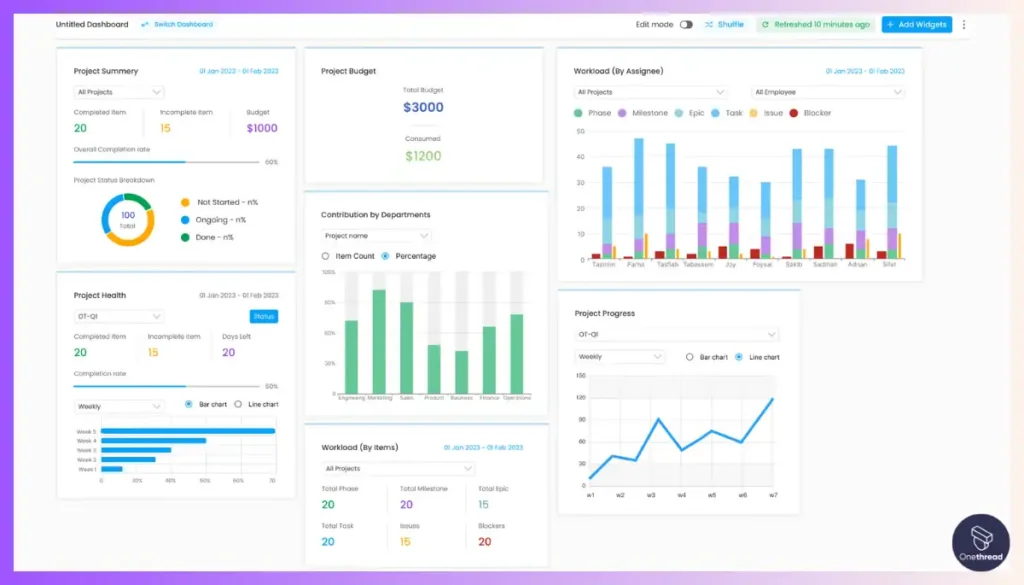
The platform’s visual dashboards and reporting tools provide insights into individual and team performance, enabling managers to identify areas for improvement and offer personalized coaching and development opportunities.
This empowers employees to take ownership of their career growth and contributes to a more engaged and motivated workforce.
5. Positivity Pays Off: Building a Supportive Culture
Think of your workplace as a team, not just a collection of individuals. Foster a positive and inclusive environment where everyone feels respected and valued. Celebrate diversity, encourage teamwork, and create a space where people feel comfortable being themselves.
6. Appreciation is Everything: Recognizing Hard Work
A simple “thank you” can go a long way! Implement a formal recognition program to acknowledge and reward outstanding contributions. Publicly praise achievements, offer bonuses or incentives and personalize your appreciation.
Remember, feeling valued is essential for employee happiness and motivation.
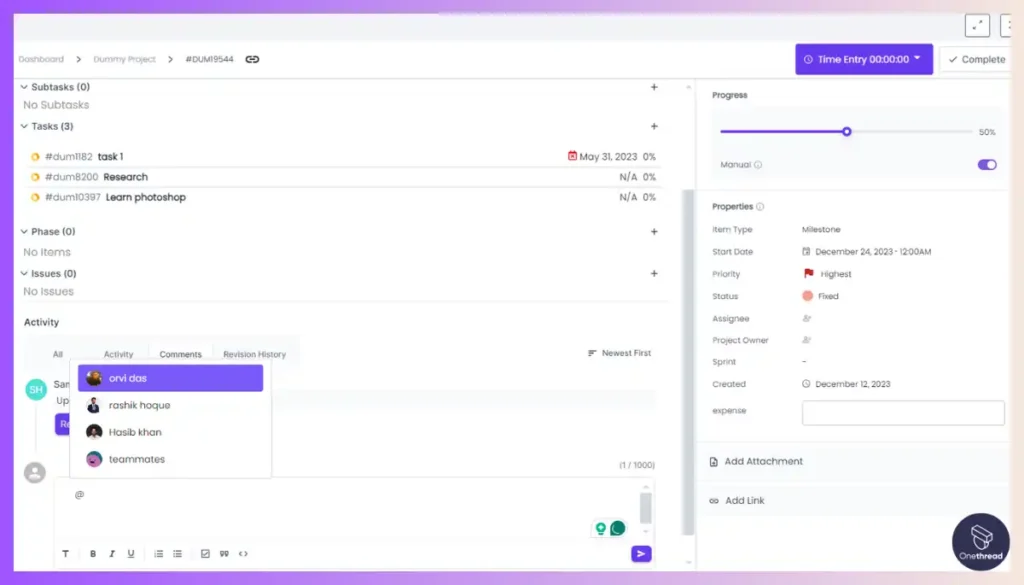
Onethread allows you to publicly recognize achievements within projects and across the organization. Team members can mention and tag colleagues in discussions, celebrating individual and team contributions.
This fosters a culture of appreciation and motivates employees to go the extra mile.
Try Onethread
Experience Onethread full potential, with all its features unlocked. Sign up now to start your 14-day free trial!
7. Beyond the Basics: Offering Comprehensive Benefits
Show your employees you care about their well-being by providing a diverse benefits package. Think health insurance, wellness programs, educational opportunities, and even child care assistance.
8. Take a Break! The Importance of Mental Refreshments
Encourages employees to take regular breaks throughout the day. Short walks, stretching sessions, or even just a few minutes of quiet time can help them recharge and refocus. Remember, a well-rested mind is a productive mind!
9. Space Matters: Designing for Comfort and Well-being
Your office environment shouldn’t be an afterthought. Redesign the space to be comfortable, and ergonomic, and promote well-being. Think natural light, comfortable furniture, and designated relaxation areas.
10. Embrace Innovation: Encouraging Creativity and Risk-Taking
Don’t stifle creativity! Encourage employees to think outside the box and explore new ideas. Create a safe space for experimentation and learning, even if it means accepting the occasional misstep.
11. Get to Know You! Understanding Individual Needs
Take the time to get to know each employee’s strengths, interests, and career aspirations. This allows you to tailor support and opportunities accordingly. By understanding individual needs, you can create a more personalized and engaging work experience.
12. Teamwork Makes the Dream Work: Collaboration over Competition
Instead of creating an environment where employees compete against each other, foster a collaborative atmosphere where they work together towards shared goals. Encourage teamwork, knowledge sharing, and mutual support.
13. Transparency is Key: Open Communication and Decision-Making
Keep your employees informed and involved! Share information openly, explain decisions clearly, and encourage questions and feedback. This creates a sense of community, reduces stress, and ultimately leads to better results for everyone.
By implementing these 13 proven methods, you can create a happier and more productive work environment for everyone. And who knows, maybe your office will become the happiest place on earth (at least for work hours)!
Work-Life Balance and Employee Satisfaction
Creating a place where everyone loves to work isn’t just about the paycheck. It’s about making sure people are happy, healthy, and have time for life outside of work. Let’s dig into how this can happen.
The Golden Rules for a Great Workplace:
Imagine a workplace where everyone feels communicated with, engaged, rewarded, embraced, and treated equally. That’s what the 5 Golden Rules are all about.
They include treating each other well, giving everyone a chance to speak up, and making sure hard work is recognized. When these rules are followed, it makes for a happy place where everyone wants to do their best.
The Work-Life Rule:
Now, think about a seesaw. On one side, you have work, and on the other, life. The goal is to keep them balanced. When work takes up too much time, there’s not enough left for fun, family, or rest.
A good work-life balance means you have time for both your job and your personal life, leading to happier and more satisfied employees.
Enhancing Employee Happiness:
Happy employees are like a secret ingredient for a successful business. But how do you make them happy? It starts with listening to what they need, like flexible hours or a chance to learn new things.
It’s also about saying “thank you” and showing them their work matters. When employees are happy, they do better work, help out more, and stick around longer.
Making a great place to work is about more than just the work. It’s about caring for each other, keeping life and work in balance, and making sure everyone feels happy and valued. When companies get this right, everyone wins.
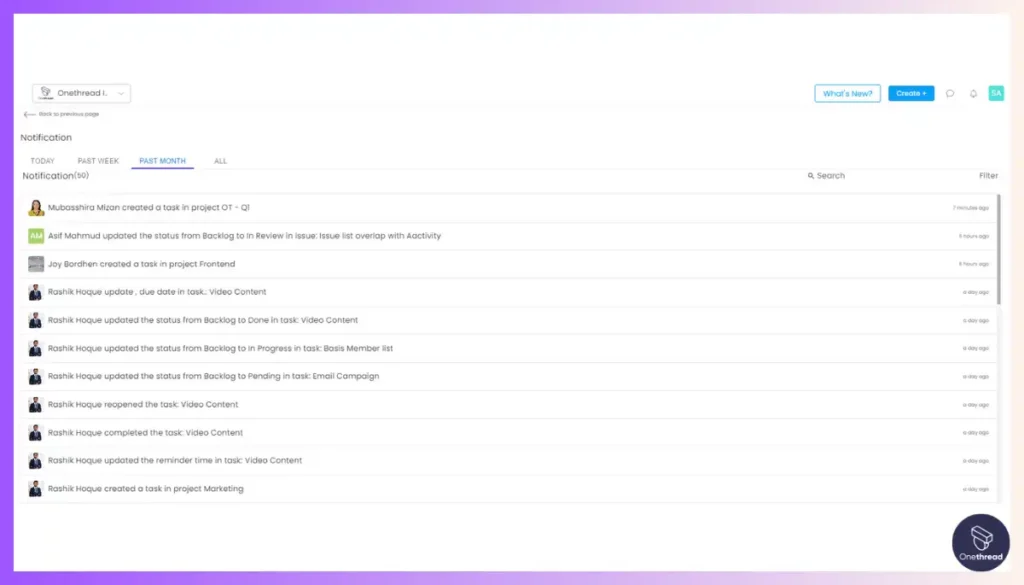
Onethread goes beyond basic task management by fostering a collaborative and communicative work environment. The platform’s built-in discussion feature, centralized project information, and real-time updates empower employees to stay connected, share ideas, and support each other.
This sense of community and collaboration contributes to a more positive and enjoyable work experience, ultimately leading to happier and more engaged employees.
Try Onethread
Experience Onethread full potential, with all its features unlocked. Sign up now to start your 14-day free trial!
Promoting Positive Employee Conduct and Etiquette
Creating a workplace where everyone feels welcome and valued is like building a friendly neighborhood. Everyone has a part to play, from saying “hello” to helping out when needed. Let’s explore how good manners and a safe environment make work a better place for everyone.
A. Office Etiquette and Team Dynamics
Office etiquette is like the rules of a game that everyone agrees to play by, making sure we all get along and work well together. It’s about saying “please” and “thank you,” listening as much as talking, and respecting each other’s space and ideas.
When everyone follows these simple rules, it’s easier to work as a team, share ideas, and solve problems together. It turns the office into a place where people feel respected and included, making teamwork not just something we do, but something we enjoy.
B. Creating a Psychologically Safe Culture
A psychologically safe workplace is one where everyone feels they can speak up without fear of being made fun of or ignored. It’s about making sure no one feels left out or treated unfairly because of who they are.
Avoiding mistakes like not listening to everyone’s ideas or letting biases influence decisions is crucial. When people feel safe, they’re more likely to share their thoughts and ideas, which can lead to better ways of doing things and solving problems.
It’s about creating an environment where everyone feels they belong and that their contributions matter.
Promoting positive conduct and creating a safe, inclusive culture is key to a happy, productive workplace. It’s about treating each other with respect, listening, and making sure everyone feels safe to share their ideas.
FAQs
Who is a happy employee?
A happy employee feels valued, and satisfied with their work, enjoys good relationships with colleagues, and finds their job meaningful. They look forward to coming to work each day.
Why do we keep employees happy?
Keeping employees happy boosts productivity, reduces turnover, and fosters a positive work environment. Happy employees are more creative, dedicated, and willing to go the extra mile.
Does working hard make you happy?
Working hard can lead to happiness when it results in a sense of accomplishment, personal growth, and recognition. However, balance is key to avoiding burnout.
What is the work-life balance in HR?
In HR, work-life balance involves creating policies that allow employees to manage their job duties alongside personal responsibilities, promoting overall well-being and job satisfaction.
Final Thoughts
Addressing the 10 rules that turn happy employees mad at work is crucial for fostering a positive workplace. Embrace the lessons from Onethread to skillfully navigate these challenges, ensuring your employees remain engaged and content.
This approach not only enhances productivity but also cements your reputation as a supportive and understanding leader.
